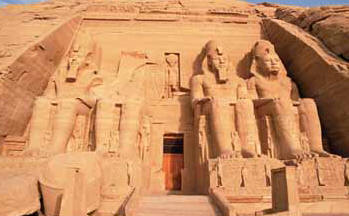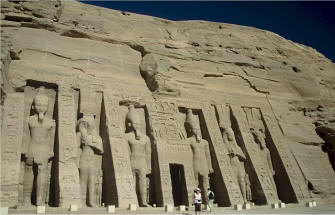The temples of Abu Simbel
Information, history and detailed description
of the Ancient temples of Abu Simbel
The two temples of Abu Simbel lie at the end of lake Nasser in the
Nubia desert of Southern Egypt. The main temple was built for the
greater glory of Ramses II. His four statues dominate the exterior. The
huge figures are 76 feet (23m) high, the head is 12 feet (4m) from ear
to ear. They depict Ramses aging from young to the left to old on the
right By the side of his leg is a statue of his wife, queen Nefertary
and above him is a statue of the God Amun. The second temple of Abu
Simbel is unique
in that it was built for queen Nefertary and dedicated to Hathor the
Goddess of Love and it was the only temple built for a queen in the
whole of Egypt. The outside has carvings of Nefertary and Ramses
together with many Hieroglyphics giving details of the lives of both
people.
 |
 |
| Temple of Abu Simbel |
Temple of Hathor in Aswan |
These temples were carved out of the solid sawan stones and this in
fact saved them for future generations. The temples eventually fell in
diffuse and covered with sand until were found by the British in the
late 1900s. The building of the Aswan High Dam 200 miles to the north
created lake Nasser and would have completely submerged Abu Simbel. In
1965 UNESCO approved and funded a Swedish plan to raise the temples 200
feet (60m) , move them 600 feet (180m) sideways to the edge of the new
lake.This entailed the building of a two reinforced concrete domes,
cutting the temples into 30 tons blocks and the rebuilding of these
blocks both within and outside of these domes. The reconstruction was
exactly as the original and no damage or faults were rectified.
Entering the Abu Simbel temple through a wooden door opened by the key of life
the statues of the three Gods and Ramses can be seen in the sanctuary on
March the 21st and September the 21st 5:58AM the ray of sun light
penetrates the temple, bathes the 3 statues in light, the forth statue
is not lit on because it is Kek the God of Darkness.
The inner chamber is supported by 8 columns each having a further
statue of the Pharaoh. The columns themselves are decorated with
carvings and paintings.
The yellow wedding dress of Nefertari is one of the best preserved
paintings of the temples.
 Many
of the wall carvings illustrate the military exploits of Ramses who
reigned for 67 years and made Egypt supreme in this area of the Middle
east. Many
of the wall carvings illustrate the military exploits of Ramses who
reigned for 67 years and made Egypt supreme in this area of the Middle
east.
Other carvings are of various Gods which can be recognized by their
animal heads. The king and queen are shown making offerings to the Gods.
One of Ramses carvings show him hold the hair of one of his enemies and
slay him with his hand held weapon.
Some of the carvings and paintings of Ramses show him wearing either
the white canonical crown of upper Egypt or the combined white and red
crowns of the united country of both upper and lower Egypt. From the
carvings of the cartouche or name plates and from other Hieroglyphics it
is possible to read the story associated with each picture. Egyptian
Hieroglyphics consists of some 700 symbols , the finding of the Rosetta
stone now in the British museum enabled these writings to be deciphered
The quality of these carvings and paintings and proportions of all
the figures are quite extraordinary which say much of the quality of the
masons in charge of these constructions which happened 3200 years ago.
A number of smaller chambers are built off the main one primarily for
the priests to store wine food etc and possibly for living
accommodation, these are well decorated but not up to the standard of
the main temples.
Abu Simbel temples are indeed a great work of art by Ancient Egyptians.
For more information about Egypt visit these pages in our website.
|